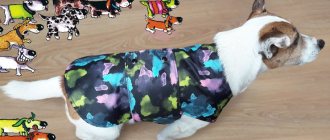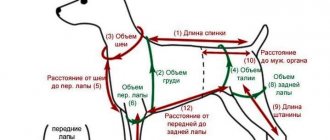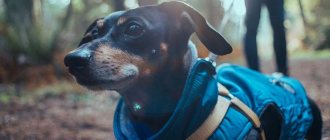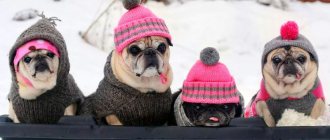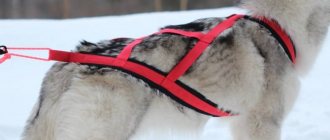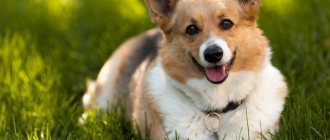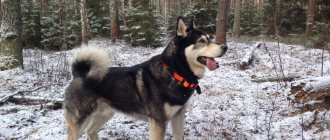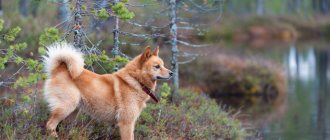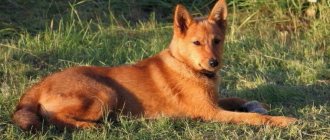I think it’s no secret for every dog owner that clothing for animals is oh so expensive. But, if you have at least minimal skill in working with a sewing machine, then by spending a small amount of money on fabric, you can easily and simply sew a dog jumpsuit with your own hands.
Earlier I already talked about how our Jackusik does not really welcome costume walks. As soon as, before going out, I start rearranging his things, choosing what to dress him in, he immediately hides under the bed... Only his cowardly nose snores with hope: what if he gets away!
But, despite the fact that Jack, to put it mildly, has a dislike for clothes, we have a fairly large wardrobe: knitted and insulated overalls, blankets, vests, raincoats. There's nothing to be done about it. Whether he likes it or not, in any case, you need to protect your pet from weather troubles.
We take basic measurements from the pet
To begin with, let's take basic measurements from the dog (as shown in the photo below): back length, neck girth and chest girth. If you are sewing a blanket or vest, these measurements are quite sufficient.
But if you want to make overalls for a dog, then it would be a good idea to also measure the length of his paws so that after cutting the legs do not end up being too short. Although, this too can be easily corrected by “increasing” the decorative cuffs.
Choosing walking shoes
In order for shoes to protect your dog’s paws from harmful chemical and mechanical influences, you need to follow the following recommendations:
Pattern of overalls for dogs
The pattern of overalls for dogs is one of the most important components. The more accurately the measurements are taken and the pattern is drawn, the better the new thing will “fit” on your pet. And in comfortable clothes, even the most fastidious “fashionist”, such as our Jack, will feel free and comfortable while walking.
The main size that must be used to guide the construction of the mesh and further application of the pattern is the length of the pet’s back from the withers to the tail.
Having measured this parameter, we divide it by 10. The resulting value is the size of the side of the square.
Let me give you an example using Jack. The length of Jack's back from the collar to the base of the tail is 30 cm. This means that I need 30:10 = 3 cm. Thus, the jack pattern grid will consist of squares, the side of each of which is 3 cm.
You may have more or less, depending on the size of your tailed companion.
Note! The blue color on the pattern shows the outlines of overalls for a boy. If you have a girl, then you just need to lengthen the part of the shelf (belly), as marked in pink.
By the way, on our blog there is another, completely different, but also very cool model of warm winter overalls. If you want to sew such a onesie for your furry friend, you will find a pattern and a detailed video master class in the article: winter overalls for dogs.
Here is this jumpsuit in all its glory.
Types of clothing
The range of clothing for corgis is very diverse:
Among the accessories necessary for a corgi, there are also leashes with collars, harnesses, and, if necessary, a muzzle.
Necessary materials
To make the jumpsuit I used the following materials:
- Membrane fabric with water protection.
- Lining fabric on padding polyester (lining stitch). Depending on how warm or not you want the overalls to be, you can use a thinner fabric (for example, flannel, fleece) as the lining layer. If you plan to use the overalls in severe frosts, then as an additional insulating layer you can use Alpolux insulation, which is quite frost-resistant.
- Tractor lightning. If you sew a zipper only along the back (without a collar), as I did, then the length of the zipper must be exactly the same as the length of your pet’s back (in my case it is 30 cm). If you plan to “extend” the zipper to the end of the collar, then its length should accordingly be greater.
Jack always wears collars with us. If I had sewn a zipper along the entire length of the overalls, including the collar, then I would have to put Jack's collar on top of the collar. After all, if I wore the collar down, the leash would constantly rub against the collar, but I don’t think that’s very comfortable. In my opinion, the long lock option is suitable if your pet wears a harness.
What are corgi clothes for?
Representatives of this breed cannot easily tolerate the effects of low temperatures. Welsh Corgis are prone to kidney disease. This, unfortunately, is a breed problem. Therefore, warm clothes will protect your pet from hypothermia and illness.
In spring and autumn, for walks with your corgi, you need water-repellent overalls, raincoats, and blankets in which the animal’s fur will be protected from rain, slush and dirt.
In the summer, it is recommended to dress your pet so that thorns do not stick to it and ticks do not attack it. It is also necessary for protection from sunlight and overheating.
Shoes are an important item in a Welsh Corgi’s wardrobe, because they protect the pet’s paws:
- from getting wet in wet weather;
- harmful effects of chemical reagents and machine fluids;
- mechanical damage from sticks, thorns, glass, which are often not visible in winter;
- snow sticking between the pads, which causes inconvenience for the pet.
Step-by-step instruction
The proposed pattern is made to fit my Jackusik, the length of his legs, the width of his chest and the girth of his neck.
There is a good saying: Measure twice, cut once! All dogs are different. Some people have longer or shorter paws. Some are more slender, while others like to eat well.
In order not to be upset later because the work went wrong, before transferring the pattern to the main fabric, make a trial version on a piece of regular chintz or any old sheet. This way you will already have an idea of what and where to “adjust”, expand, lengthen or shorten specifically for your pet.
I didn’t make a “trial” version, since this pattern has already been tested. I used it to sew a vest for Jack. The only thing I had to additionally measure was the length of Jackusik's paws.
Our first fitting looked exactly like this! I caught that rare moment when Jack was motionless and dozing.
Yes, if you use a thicker lining layer as insulation, I advise you to initially transfer the pattern to the fabric, adding an additional 1-2 cm to the constructed pattern. It is better later, during the fitting process, to sew in a little excess, rather than the overalls turning out to be tight.
So, we transfer all the details of the pattern to both the main (membrane) and lining fabric.
Next, carefully cut everything out, not forgetting to add 1-1.5 cm for seam allowances.
The most important controller strictly monitors the entire production process!
From the wrong side, on the sides, we sew together the parts of the front (belly) and back. We perform this operation with both membrane and lining fabric.
Important advice! Before thoroughly sewing all the seams on a sewing machine, I advise you to first manually baste the parts together and first try the product on your pet. The more often you try on, the better the overalls will “fit” your tailed friend.
During fitting, especially for boys, we check the cutout on the tummy to see if it covers the waistband. After all, the next stage of making the overalls will be this part of the product.
We fold the parts of the membrane and lining fabric, already stitched on the sides, together “face to face” and sew along the bottom, in the tummy area, as shown by the red dotted line.
We turn it inside out and, in the same way, in the tummy area, only on the front side, we lay an additional finishing line.
So that during the final stitching on the sewing machine the fabric does not “walk” and the seam is neater, I first swept this place manually with temporary large stitches.
This is what it should look like in the end.
To ensure that the top and lining of the overalls are securely fixed to each other in the future, it is better to additionally stitch the side seams on the front side using a machine.
We sweep away the shoulder sections and try the product on the pet. If the overalls fit well in the shoulders, feel free to stitch the shoulder sections using a sewing machine.
But then I recommend trying it on again to make sure that the armholes do not put pressure on the armpits. If the armhole is too tight, it is better to cut off the excess so that there are no chafing later. Let it be a little more free.
Let's start sewing in the parts of the front legs (let's call them sleeves).
This is one of the most critical stages, and there is absolutely no need for haste here. Before finally sewing in the sleeves, I advise you to sew them into the armhole and try them on again.
Yes, we have already adjusted the armhole to fit the pet’s paws. But, when sewn in, due to the seam, it may also decrease slightly. You may have to cut off the excess again. And during intermediate fitting, you can immediately adjust the length of the front legs of the overalls.
So, as a result of the fitting, we “adjusted” everything. Now, we fold the lining and membrane fabrics of both parts of the paws “face to face” and stitch along the bottom using a sewing machine.
And then according to the well-known scheme: we turn it inside out and also add an additional finishing line along the bottom (as shown by the arrows).
Next, you can sew the sleeves to the overalls. But before doing this, I usually blur the details together. I do this so that they don’t move in different directions again.
All that remains is to finally sew everything on the sewing machine.
Well, the front legs (sleeves) are completely ready, let's proceed to the details of the hind legs of the overalls.
The scheme is the same: we fold the lining and membrane fabrics of both parts of the paws “face to face”, stitch along the bottom from the wrong side, and turn them inside out.
We lay the finishing line.
Now we need to finish the edges of the overalls in the area of the tail and butt.
We turn this part of the overalls inside out and sew a seam on the wrong side using a sewing machine.
And again we turn the overalls right side out, and exactly there (in the area of the tail and butt) we make the finishing stitch.
And then we fold the membrane fabric “face to face” in the area of the hind legs and sew it where shown by the dotted line.
Before we start sewing in the lock, we do a fitting to make sure that our overalls fit freely on the pet and do not squeeze anything anywhere. In addition, we take into account that when sewing in a lock, the jumpsuit “unexpectedly” should not turn out to be too tight.
If you suddenly find that there is not enough fabric on the back, and after sewing in the lock, the jumpsuit turns out to be too tight, then you can “increase” the missing volume by sewing on an additional strap. I already encountered this once when I sewed a vest for a dog with my own hands. You can read by following the link about how I got out of this situation.
Next, we sew in the lock.
And again we carry out, one might say, the final fitting. We make sure that there is no pressure anywhere in the neck area, since the final stage of making overalls for a dog will be sewing on the collar.
I will not describe the entire process in detail, since there is nothing complicated here. The following photos reflect everything in sufficient detail.
Well, as it turns out, it’s not so difficult to sew your own overalls for a dog.
If, after completing the work, you find some shortcomings: the fabric on the tummy is puffy, or the parts of the legs are too wide, and the pet is not very comfortable on a walk, you can make small corrections.
For example, in the tummy area, on the inside, additionally sew a wide elastic band (as shown in the master class on making a vest). And the parts of the front and back legs of the overalls can be slightly bent and elastic bands can also be sewn in.
Well, we have already tested the new thing in the field! Jackusik feels great in his new overalls. Apparently, it was not for nothing that we did not skimp on frequent fittings. Everything turned out just great!
Even at the sight of overalls, my little toothy one does not try to hide under the bed, which is very surprising... He probably liked the overalls!
If you found this material useful, I would be glad to see your feedback in the comments. If you decide to sew such a onesie for your pet, but questions arise during the manufacturing process, then do not hesitate to ask questions in the comments to this material. I will be happy to help you!
Clothing requirements
When purchasing clothes, you need to consider the following requirements:
- The seams on wardrobe items must be done carefully, brought out, so as not to rub calluses and not cause discomfort to the dog.
- Clothing should be easy and quick to put on and take off.
- For the rainy season, you need to choose anti-mud overalls and raincoats made of waterproof, water-repellent fabric that protect against blowing and getting wet. Such materials can prevent diseases in the Pembroke and Cardigan Welsh Corgis. This could be, for example, raincoat fabric or bologna. Winter versions of such clothing should have a warm lining.
- It is better to purchase things from high-quality materials that will not fade or stain the animal. Low-quality, cheap fabrics can cause allergies and skin rashes in your corgi.
Overalls for dachshund
Beginners are not recommended to start sewing complex clothes. It would be best if the first job was to make a blanket. The dog won't be cold in this outfit. A funny product will definitely attract the attention of others.
- Place the pattern on the fabric from the wrong side and outline it with chalk.
- Cut, but make allowances of about a centimeter around the entire perimeter.
- Sew a piece of fabric measuring 11x17 cm for the breast.
- Sew darts on the back of the blanket.
- Edge the workpiece around the edge.
- Sew Velcro on the side and chest.
The dog won't be cold in this outfit
Advice: if you plan to wear clothes in winter, you additionally need to cut out a lining from padding polyester.
What happens: description and photo
Shoes and clothing for a toy terrier are a must not only in cold weather, but also in everyday life. It can be roughly divided into groups:
- Hygienic. This type of clothing is designed to get rid of stains and dirt caused by the physiological secretions of dogs. For example, specialized panties for girls protect against discharge during estrus, and a hygiene belt prevents boys from marking their territory in the apartment.
- Casual walking. This clothing is great for daily walks. It is very convenient and comfortable. In the cold season, knitted sweaters, warm jackets, and pants are perfect.
- Festive. Suitable for special occasions. These are very bright, beautiful clothes made of expensive material and decorations. Overalls, blouses, ties, trousers that were purchased in an expensive boutique or specially sewn with your own hands, to order. Such clothing should not hinder your pet’s movements or make him nervous.
Remember, clothes and shoes must first of all fulfill their main function of protecting the dog from the cold, and only then their aesthetic function.
Here you can see photos of dogs of this breed in clothes of different models:
Suits
Dogs can celebrate any occasion in a stylish, comfortable outfit. Even a simple bandana from your pet can add a little holiday cheer to your family and friends. Bandanas and scarves with fun designs or colors fit comfortably around your dog's neck, even on hot days. Your dog can be dressed up as your favorite TV character, superhero or celebrity. You can cheer for your team and dress your dog in clothes with their symbols.
We present to your attention fancy dress costumes for corgis and other small breeds. Christmas clothes for the dog. Deer costume. Priced from only 247 rubles.
A fun apron for corgis and other breeds. Priced from 643 rubles.
Building a basic pattern for modeling and sewing
Algorithm for creating a pattern:
- You need to take measurements from the dog. Without them, creating a pattern will be irrelevant.
- First, a right angle is built upside down, where one side of the angle is the height at the withers, and the other is the length from the neck to the tail.
- A line is drawn parallel to one of the sides, the distance between them is determined by the half-circumference of the neck.
- On the new laid line you need to mark a segment that will determine the length from the bottom of the front paw to the neck. And one more parallel line in relation to the first two (half chest circumference).
- Next, 1 more parallel line is formed, which determines the half-girth of the abdomen.
- Then, on the resulting diagram, you need to plot the lines that determine the circumference of the paws.
- Now you need to build the “back” part of the pattern using the same principle.
Raincoat
One of them is this autumn raincoat blanket for a dog. It will be more closed than the blanket that I sewed before, and will better cover the entire body of the barbosie.
I spent a long time looking for a style that I liked. And I accidentally “stumbled upon” dog clothing manufacturers who have a lot of different cool things for our tailed friends. I liked exactly this model of blanket.
And I decided to repeat it.
Photo greetings
And here are photo greetings from the dogs, for whom their caring owners sewed blankets according to our master class. I think it turned out great! How do you think?
The Welsh Corgi breed has a good dense coat and a thick undercoat. Therefore, many people mistakenly believe that with such a fur coat in winter, the dog will not need additional insulation. But an experienced breeder will definitely say: clothes for a corgi are needed in any season!
Final finishing work
The bottom of the trouser legs is folded inward twice, and an elastic band is inserted into the lapel. If you need to adjust the width of the bottom of the leg according to the situation, you can replace the elastic with a narrow drawstring with a cord or a cuff with a clip. You can also finish the edges with elastic bias tape.
The cutout for the tail is finished with piping and elastic so that the overalls fit the dog's body. A male dog needs one more obligatory hole - for a peephole, so that he can relieve himself normally (cut out and processed in this way).
Insulated winter blanket
And here is the second blanket for the pet. This is a warmer winter blanket for a dog.
I also saw this model on the Internet.
And I decided to sew the same cool insulated winter blanket for my Jack.
